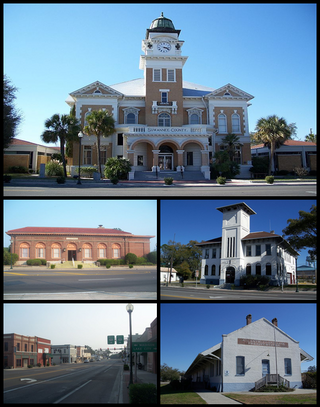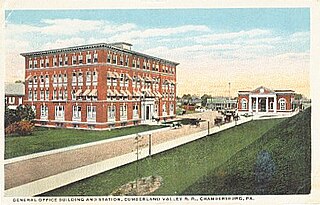| Live Oak & Gulf Railway | ||||||||||||||||||||||||||||||||||||||||||||||||||||||||||||||||||||
|---|---|---|---|---|---|---|---|---|---|---|---|---|---|---|---|---|---|---|---|---|---|---|---|---|---|---|---|---|---|---|---|---|---|---|---|---|---|---|---|---|---|---|---|---|---|---|---|---|---|---|---|---|---|---|---|---|---|---|---|---|---|---|---|---|---|---|---|---|
 | ||||||||||||||||||||||||||||||||||||||||||||||||||||||||||||||||||||
| Technical | ||||||||||||||||||||||||||||||||||||||||||||||||||||||||||||||||||||
| Line length | 20 miles (32 km) | |||||||||||||||||||||||||||||||||||||||||||||||||||||||||||||||||||
| Track gauge | 4 ft 8+1⁄2 in (1,435 mm) standard gauge | |||||||||||||||||||||||||||||||||||||||||||||||||||||||||||||||||||
| ||||||||||||||||||||||||||||||||||||||||||||||||||||||||||||||||||||
The Live Oak & Gulf Railway was a standard gauge railway in Florida which was privately owned and operated from 1895 to 1916.
| Live Oak & Gulf Railway | ||||||||||||||||||||||||||||||||||||||||||||||||||||||||||||||||||||
|---|---|---|---|---|---|---|---|---|---|---|---|---|---|---|---|---|---|---|---|---|---|---|---|---|---|---|---|---|---|---|---|---|---|---|---|---|---|---|---|---|---|---|---|---|---|---|---|---|---|---|---|---|---|---|---|---|---|---|---|---|---|---|---|---|---|---|---|---|
 | ||||||||||||||||||||||||||||||||||||||||||||||||||||||||||||||||||||
| Technical | ||||||||||||||||||||||||||||||||||||||||||||||||||||||||||||||||||||
| Line length | 20 miles (32 km) | |||||||||||||||||||||||||||||||||||||||||||||||||||||||||||||||||||
| Track gauge | 4 ft 8+1⁄2 in (1,435 mm) standard gauge | |||||||||||||||||||||||||||||||||||||||||||||||||||||||||||||||||||
| ||||||||||||||||||||||||||||||||||||||||||||||||||||||||||||||||||||
The Live Oak & Gulf Railway was a standard gauge railway in Florida which was privately owned and operated from 1895 to 1916.
Charles White and James White from New York City, who managed French real estate in Citra, founded the Live Oak & Gulf Railway Company together with Robert L. Anderson from Ocala on January 4, 1895 with a share capital of $5,000. Anderson was President, Charles White was Vice President and James White was Secretary and Treasurer. They took over the track and assets of Live Oak, Luraville & Deadman's Bay Railroad (LOL&DBRR), but not their charter. [1]
Robert Anderson had initially 5 shares, Charles White 10 and James White 35, but on March 5, 1895 the capital was increased to $150,000, although at that time only $5,000 had been used. W.C. Remick and Thomas McIntosh of LOL&DBRR were also brought on board and held 5 shares each, which they took over from Charles and James White. A mortgage account was opened with New York Security and Trust Co. in New York City. [1]
Construction began at high speed in February 1895, so that a mile (1.6 km) of track had already been laid on March 1, 1895. James R. Morehead supervised the construction as a so-called roadmaster. On May 15, 1895, the entire 12 miles long line from Dowling's Log Railroad terminus to the Suwannee River at Peek, 2 miles west of Luraville, was completed. Bonds worth $100,000 were issued by the mortgage bank. [1]
Operation started on 1 May 1895 with Charles McGehee from Live Oak as General Manager. The Live Oak & Gulf Railway had two locomotives. The engine shed was located on the premises of the mill in Live Oak. The company also owned a passenger car and a matching luggage car. Two flat cars rounded off the fleet. The first year of operation went very well: more than 9,000 tons of phosphate were transported with a turnover of $11,388. The Company earned $1,854 for the transportation of general cargo and $1,036 for the transportation of passengers. Expenses amounted to only $6,080, resulting in a positive result. [1]
1897 was a bad year and a turning point for the Live Oak & Gulf Railway, as phosphate production was discontinued at the end of 1896, after it had been determined that the iron content was too high. In 1897, no phosphate was shipped at all, and the railway had to shift its focus from transporting ore to transporting goods in general. Live Oak & Gulf was merged with Suwannee & San Pedro Railroad (S&SP) on June 30, 1905 to form Florida Railway. The Florida Railway operated the line to Luraville and the original 9 miles (14.5 km) of the former LO&G for the next eleven years until the line was closed in 1916 and the rails were lifted. [2]

Rail transport is a means of transport using wheeled vehicles running in tracks, which usually consist of two parallel steel rails. Rail transport is one of the two primary means of land transport, next to road transport. It is used for about 8% of passenger and freight transport globally, thanks to its energy efficiency and potentially high speed.

A train is a series of connected vehicles that run along a railway track and transport people or freight. Trains are typically pulled or pushed by locomotives, though some are self-propelled, such as multiple units. Passengers and cargo are carried in railroad cars, also known as wagons. Trains are designed to a certain gauge, or distance between rails. Most trains operate on steel tracks with steel wheels, the low friction of which makes them more efficient than other forms of transport.

Suwannee County is a county located in the north central portion of the state of Florida. As of the 2020 census, the population was 43,474, up from 41,551 in 2010. Its county seat is Live Oak. Suwannee County was a dry county until August 2011, when the sale of alcoholic beverages became legal in the county.

Live Oak is a city and the county seat of Suwannee County, Florida, United States. The city is located east of Tallahassee. As of 2020, the population recorded by the U.S. Census Bureau was 6,735.

The Seaboard Coast Line Railroad was a Class I railroad company operating in the Southeastern United States beginning in 1967. Its passenger operations were taken over by Amtrak in 1971. Eventually, the railroad was merged with its affiliate lines to create the Seaboard System in 1983.

The Illinois Central Railroad, sometimes called the Main Line of Mid-America, was a railroad in the Central United States, with its primary routes connecting Chicago, Illinois, with New Orleans, Louisiana, and Mobile, Alabama, and thus, the Great Lakes to the Gulf of Mexico. A line also connected Chicago west to Sioux City, Iowa (1870). There was a significant branch to Omaha, Nebraska (1899), west of Fort Dodge, Iowa, and another branch reaching Sioux Falls, South Dakota (1877), starting from Cherokee, Iowa. The IC also serviced Miami, Florida, on trackage owned by other railroads.

The Seaboard Air Line Railroad, which styled itself as "The Route of Courteous Service", was an American railroad that existed from April 14, 1900, until July 1, 1967, when it merged with the Atlantic Coast Line Railroad, its longtime rival, to form the Seaboard Coast Line Railroad. Predecessor railroads dated from the 1830s and reorganized extensively to rebuild after the American Civil War. The company was headquartered in Norfolk, Virginia, until 1958, when its main offices were relocated to Richmond, Virginia. The Seaboard Air Line Railway Building in Norfolk's historic Freemason District still stands and has been converted into apartments.
The Atlantic, Suwannee River and Gulf Railroad Company was a railroad that ran westward from Starke, Florida, eventually terminating at Wannee, Florida, on the Suwannee River. It was later absorbed by the Seaboard Air Line Railroad becoming their Wannee Subdivision.

The Louisville and Nashville Railroad, commonly called the L&N, was a Class I railroad that operated freight and passenger services in the southeast United States.

Rail transportation in the United States consists primarily of freight shipments along a well integrated network of standard gauge private freight railroads that also extend into Canada and Mexico. The United States has the largest rail transport network size of any country in the world, at a total of approximately 160,000 miles (260,000 km).
The Ulster and Delaware Railroad (U&D) was a railroad located in the state of New York. It was often advertised as "The Only All-Rail Route to the Catskill Mountains." At its greatest extent, the U&D extended 107 miles (172 km) from Kingston Point on the Hudson River through the Catskill Mountains to its western terminus at Oneonta, passing through the counties of Ulster, Delaware, Schoharie and Otsego.
The Tallahassee Railroad, headquartered in Tallahassee, Florida, was one of the first two railroads in Florida, starting operations in 1836 or 1837. It did not successfully use steam locomotives until 1855, with trains being pulled by mules for more than 20 years. The principal source of traffic on the railroad for many years was carrying cotton bales from Tallahassee to seaports on the St. Marks River.

The Union Depot and Atlantic Coast Line Freight Station is a historic site in Live Oak, Florida, United States. It is located at 208 North Ohio Avenue, on the corner of Haines Street Northeast. The station was built at one of two junctions of an Atlantic Coast Line Railroad and Seaboard Air Line Railroad lines.

The Cumberland Valley Railroad was an early railroad in Pennsylvania, United States, originally chartered in 1831 to connect with Pennsylvania's Main Line of Public Works. Freight and passenger service in the Cumberland Valley in south central Pennsylvania from near Harrisburg to Chambersburg began in 1837, with service later extended to Hagerstown, Maryland, and then extending into the Shenandoah Valley to Winchester, Virginia. It employed up to 1,800 workers.
Live Oak, Perry & South Georgia Railway was a 123-mile-long Class III railroad that operated freight service in the U.S. between Florida and Georgia from its 1971 creation, which was the result of a merger, until it was merged into the Norfolk Southern Railway (NS) in 1994. The line formerly owned three General Electric 70-ton switchers, LOP&G owning #300 and #301 while the South Georgia owned 202, which was later renumbered to #292 when the Southern acquired the Central of Georgia RR due to a numbering conflict. LOP&G #301 was sold in 1956 while the other two 70-ton switchers were retired in 1969. The LOP&G also owned two EMD GP9s that were built as part of the Southern's order for the same, with these units becoming #302 and #303, but they were later renumbered when the CofG was acquired to #298 and #299, and renumbered again when Southern consolidated their early Geep fleet, being renumbered SOU #6250 and #6251 in the early-1970s. Both of these units were retired in 1983. Operations over the lines were managed by the Southern Railway (SOU) and later by successor NS.
The Jacksonville & Southwestern Railroad (J&SW) was a railroad that served Florida from 1899 to 1904. It was purchased by the Atlantic Coast Line Railroad in 1904. The Atlantic Coast Line would extend the line further west and it would become their Jacksonville—Wilcox Line. Some of the original right-of-way was converted to a recreational path in the rails to trails program in the 1990s.
The Live Oak, Tampa and Charlotte Harbor Railroad was a historic railroad in Florida chartered by railroad tycoon Henry B. Plant. It was built as an extension of Plant's Live Oak and Rowlands Bluff Railroad. Together, the two lines ran from Live Oak, Florida to Gainesville via High Springs. The lines were completed in 1884.
The Tampa and Jacksonville Railway was a railroad in North Central Florida in the first half of the 20th century, with a length of 56 miles (90 km) at its greatest extent. It operated under several names in the half century of its existence.
The Atlantic Coast Line Railroad's DuPont—Lakeland Line was a historic rail line in southern Georgia and the northern west coast of Florida. On employee timetables, the line was actually divided into the DuPont—High Springs Line and the High Springs—Lakeland Line. The line was primarily used for freight, though some passenger services ran on parts of it in Florida. While parts of the line were built as early as 1863, the full line was not complete until 1913. Parts of the line in Florida are still active today.